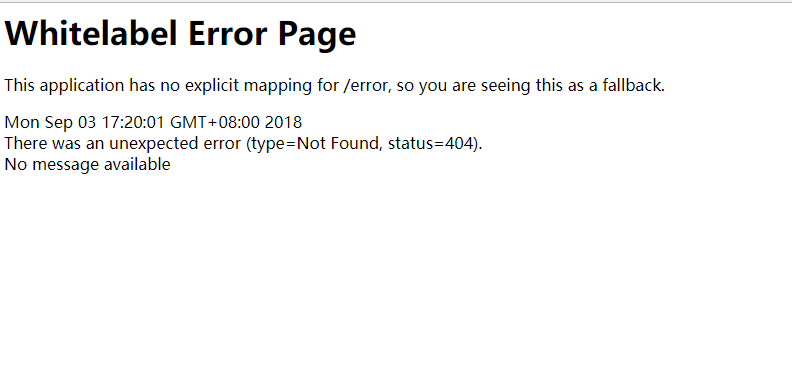springboot情操陶冶-web配置(二)
承接前文springboot情操陶冶-web配置(一),在分析mvc的配置之前先了解下其默认的错误界面是如何显示的
404界面
springboot有个比较有趣的配置server.error.whitelabel.enabled,可用来管理404界面的显示方式,是简单的显示还是详细的显示。
指定为false的时候,则会简简单单的显示视图找不到的错误信息,如下

指定为true的时候(默认配置),则会显示前文样例中的错误信息,如下

源码层分析
springboot安排了ErrorMvcAutoConfiguration自动配置类来处理错误页面的相关信息,笔者分几个步骤来进行分析
No.1 脑壳上的注解看一发
@Configuration
@ConditionalOnWebApplication(type = Type.SERVLET)
@ConditionalOnClass({ Servlet.class, DispatcherServlet.class })
// Load before the main WebMvcAutoConfiguration so that the error View is available
@AutoConfigureBefore(WebMvcAutoConfiguration.class)
@EnableConfigurationProperties({ ServerProperties.class, ResourceProperties.class })
public class ErrorMvcAutoConfiguration {
}
可以看出其是排在WebMvcAutoConfiguration配置类之前的,那么为什么需要排在前面呢?看注释是说这样才可以使error视图有效,那怎么实现的呢?笔者带着问题继续往下探索
No.2 DefaultErrorViewResolverConfiguration内部类-错误视图解析器注册
@Configuration
static class DefaultErrorViewResolverConfiguration {
private final ApplicationContext applicationContext;
private final ResourceProperties resourceProperties;
DefaultErrorViewResolverConfiguration(ApplicationContext applicationContext,
ResourceProperties resourceProperties) {
this.applicationContext = applicationContext;
this.resourceProperties = resourceProperties;
}
// 注册了DefaultErrorViewResolver解析器
@Bean
@ConditionalOnBean(DispatcherServlet.class)
@ConditionalOnMissingBean
public DefaultErrorViewResolver conventionErrorViewResolver() {
return new DefaultErrorViewResolver(this.applicationContext,
this.resourceProperties);
}
}
DefaultErrorViewResolver这个默认的错误视图解析器很有意思,里面包含了一些默认的处理,也分几个小步骤来吧,这样会显得清晰
- 静态方法了解
static {
Map<Series, String> views = new EnumMap<>(Series.class);
views.put(Series.CLIENT_ERROR, "4xx");
views.put(Series.SERVER_ERROR, "5xx");
SERIES_VIEWS = Collections.unmodifiableMap(views);
}
应该是对HTTP状态码的映射处理,以4开头的是客户端错误,5开头的为服务端错误
- 构造函数了解
public DefaultErrorViewResolver(ApplicationContext applicationContext,
ResourceProperties resourceProperties) {
Assert.notNull(applicationContext, "ApplicationContext must not be null");
Assert.notNull(resourceProperties, "ResourceProperties must not be null");
this.applicationContext = applicationContext;
this.resourceProperties = resourceProperties;
// 模板加载器
this.templateAvailabilityProviders = new TemplateAvailabilityProviders(
applicationContext);
}
上述的模板加载器主要是读取所有spring.factories中的org.springframework.boot.autoconfigure.template.TemplateAvailabilityProvider对应的属性值,本质也就是模板的渲染器,比如我们常用的freemarker、velocity、jsp等等
- 视图对象获取了解
@Override
public ModelAndView resolveErrorView(HttpServletRequest request, HttpStatus status,
Map<String, Object> model) {
// 优先根据状态码来查找view静态资源,比如404则会查找error/404视图
ModelAndView modelAndView = resolve(String.valueOf(status), model);
if (modelAndView == null && SERIES_VIEWS.containsKey(status.series())) {
// 上述不存在则再查找error/4xx或者error/5xx视图
modelAndView = resolve(SERIES_VIEWS.get(status.series()), model);
}
return modelAndView;
}
private ModelAndView resolve(String viewName, Map<String, Object> model) {
String errorViewName = "error/" + viewName;
// 通过模板加载器查找是否含有符合要求的视图资源
TemplateAvailabilityProvider provider = this.templateAvailabilityProviders
.getProvider(errorViewName, this.applicationContext);
if (provider != null) {
return new ModelAndView(errorViewName, model);
}
return resolveResource(errorViewName, model);
}
// 默认查找staticLocation指定路径的资源,比如classpath:/static/error/404.html
private ModelAndView resolveResource(String viewName, Map<String, Object> model) {
for (String location : this.resourceProperties.getStaticLocations()) {
try {
Resource resource = this.applicationContext.getResource(location);
resource = resource.createRelative(viewName + ".html");
if (resource.exists()) {
// view类型为HtmlResourceView,直接将html资源输出到response对象中
return new ModelAndView(new HtmlResourceView(resource), model);
}
}
catch (Exception ex) {
}
}
return null;
}
通过上述的代码注释,基本可以得知错误视图的查找规则,所以用户可以简单的在static目录下配置对应状态码的页面比如error/404.html或者error/500.html;当然也可以配置统一的页面error/4xx.html或者error/5xx.html
那如果我们啥也不指定,那上述的错误提示信息是如何展示的呢?
No.3 WhitelabelErrorViewConfiguration-白板错误视图配置
// server.error.whitelabel.enabled开关,默认是打开的
@Configuration
@ConditionalOnProperty(prefix = "server.error.whitelabel", name = "enabled", matchIfMissing = true)
@Conditional(ErrorTemplateMissingCondition.class)
protected static class WhitelabelErrorViewConfiguration {
// 熟悉的打印信息
private final SpelView defaultErrorView = new SpelView(
"<html><body><h1>Whitelabel Error Page</h1>"
+ "<p>This application has no explicit mapping for /error, so you are seeing this as a fallback.</p>"
+ "<div id='created'>${timestamp}</div>"
+ "<div>There was an unexpected error (type=${error}, status=${status}).</div>"
+ "<div>${message}</div></body></html>");
// 创建了名为error的视图对象
@Bean(name = "error")
@ConditionalOnMissingBean(name = "error")
public View defaultErrorView() {
return this.defaultErrorView;
}
// 与上面的View对象搭配使用
@Bean
@ConditionalOnMissingBean
public BeanNameViewResolver beanNameViewResolver() {
BeanNameViewResolver resolver = new BeanNameViewResolver();
resolver.setOrder(Ordered.LOWEST_PRECEDENCE - 10);
return resolver;
}
}
上述就是我们开头可见的错误信息的处理处,详细的用户可自行查阅代码
No.4 构造函数了解
public ErrorMvcAutoConfiguration(ServerProperties serverProperties,
ObjectProvider<List<ErrorViewResolver>> errorViewResolversProvider) {
this.serverProperties = serverProperties;
this.errorViewResolvers = errorViewResolversProvider.getIfAvailable();
}
上述的errorViewResolverProvider便会加载第二步骤的DefaultViewResolver,当然用户也可以自定义去实现ErrorViewResolver接口。这些错误的视图解析器将会在下一步骤的controller层被调用
No.5 error控制器注册
@Bean
@ConditionalOnMissingBean(value = ErrorAttributes.class, search = SearchStrategy.CURRENT)
public DefaultErrorAttributes errorAttributes() {
return new DefaultErrorAttributes(
this.serverProperties.getError().isIncludeException());
}
// 创建BasicErrorController控制器用于响应server.error.path指定的路径,默认为/error
@Bean
@ConditionalOnMissingBean(value = ErrorController.class, search = SearchStrategy.CURRENT)
public BasicErrorController basicErrorController(ErrorAttributes errorAttributes) {
return new BasicErrorController(errorAttributes, this.serverProperties.getError(),
this.errorViewResolvers);
}
此处的BasicErrorController对象则会默认响应/error的请求,其内部写了一个返回html页面的响应方法
@RequestMapping(produces = "text/html")
public ModelAndView errorHtml(HttpServletRequest request,
HttpServletResponse response) {
HttpStatus status = getStatus(request);
Map<String, Object> model = Collections.unmodifiableMap(getErrorAttributes(
request, isIncludeStackTrace(request, MediaType.TEXT_HTML)));
// 状态码设置
response.setStatus(status.value());
// 调用errorViewResolvers集合去获取对应的错误视图
ModelAndView modelAndView = resolveErrorView(request, response, status, model);
// 如果没指定相应的视图,则会采用默认的名为error的视图
return (modelAndView != null ? modelAndView : new ModelAndView("error", model));
}
对上述代码的注释作下简单的解释,帮助读者们理顺下思路
- 首先其会调用所有实现了ErrorViewResolver接口的视图解析器去找寻相应的错误视图,并支持通过Order接口进行排序。所以此处默认情况下会调用DefaultErrorViewResolver来获取view,具体的如果获取可见上文的讲解
- 如果上述找到了,那么也就么事了,但是如果还没找到,则会默认指定名为error的视图。
- 那么如何去解析默认名为error的视图呢?答案在DispatcherServlet在最终确定渲染视图的时候,会统一调用所有实现了ViewResolver接口的视图解析器去获取视图对象,那么第三步骤中的BeanNameViewResolver对象便会找寻到对应的SpelView视图,由其来进行相应的渲染
在此处笔者回答下开头的问题,为什么ErrorMvcAutoConfiguration需要放在DispatcherServletAutoConfiguration之前,其实最主要的是后者并没有去注册BeanViewResolver,此处上了一份保险,好让能正确的找到SpelView对象
error请求问题
经过上文的分析,我们知道了BasicErrorController用来处理访问方式为GET [/error]的请求并处理得到相应的错误视图,那么最重要的问题来了,到底怎么在出现资源找不到的时候去路由至此路径上呢?笔者继续带着这个问题去探索
No.1 ErrorPageCustomizer-错误页面配置
@Bean
public ErrorPageCustomizer errorPageCustomizer() {
return new ErrorPageCustomizer(this.serverProperties);
}
private static class ErrorPageCustomizer implements ErrorPageRegistrar, Ordered {
private final ServerProperties properties;
protected ErrorPageCustomizer(ServerProperties properties) {
this.properties = properties;
}
@Override
public void registerErrorPages(ErrorPageRegistry errorPageRegistry) {
// 默认路径为/error
ErrorPage errorPage = new ErrorPage(
this.properties.getServlet().getServletPrefix()
+ this.properties.getError().getPath());
// 注册
errorPageRegistry.addErrorPages(errorPage);
}
@Override
public int getOrder() {
return 0;
}
}
上述的errorPage貌似展示了一点信息,可能是会去访问/error的源头,那么ErrorPageCustomizer#registerErrorPages()是如何被调用的呢?继续往下
No.2 ServletWebAutoConfiguration引入的时候还注册了一个BeanPostProcessor
@Override
public void registerBeanDefinitions(AnnotationMetadata importingClassMetadata,
BeanDefinitionRegistry registry) {
if (this.beanFactory == null) {
return;
}
registerSyntheticBeanIfMissing(registry,
"webServerFactoryCustomizerBeanPostProcessor",
WebServerFactoryCustomizerBeanPostProcessor.class);
// 就是这个
registerSyntheticBeanIfMissing(registry,
"errorPageRegistrarBeanPostProcessor",
ErrorPageRegistrarBeanPostProcessor.class);
}
我们直接去关注其主要的方法
// 注册了相应的错误界面
private void postProcessBeforeInitialization(ErrorPageRegistry registry) {
for (ErrorPageRegistrar registrar : getRegistrars()) {
registrar.registerErrorPages(registry);
}
}
private Collection<ErrorPageRegistrar> getRegistrars() {
if (this.registrars == null) {
// Look up does not include the parent context
this.registrars = new ArrayList<>(this.beanFactory
.getBeansOfType(ErrorPageRegistrar.class, false, false).values());
this.registrars.sort(AnnotationAwareOrderComparator.INSTANCE);
this.registrars = Collections.unmodifiableList(this.registrars);
}
return this.registrars;
}
至于为什么在该类中去注册这个processor去执行注册错误页面,看来这个路径的转发应该与web容器有关。其实追踪源头其实将错误界面注册到了相应的web容器中(Tomcat),具体的读者可自行去分析。
No.4 web容器加载(插曲,顺带提一下)
我们都知道springboot对环境为Servlet所采用的ApplicationContext为AnnotationConfigServletWebServerApplicationContext,其父类在刷新上下文过程中的onRefresh()方法便去启动了web容器
@Override
protected void onRefresh() {
super.onRefresh();
try {
// 创建web服务器
createWebServer();
}
catch (Throwable ex) {
throw new ApplicationContextException("Unable to start web server", ex);
}
}
private void createWebServer() {
WebServer webServer = this.webServer;
ServletContext servletContext = getServletContext();
if (webServer == null && servletContext == null) {
// 默认为TomcatServletWebServerFactory
ServletWebServerFactory factory = getWebServerFactory();
// 初始化servlet/filter等
this.webServer = factory.getWebServer(getSelfInitializer());
}
else if (servletContext != null) {
try {
getSelfInitializer().onStartup(servletContext);
}
catch (ServletException ex) {
throw new ApplicationContextException("Cannot initialize servlet context",
ex);
}
}
initPropertySources();
}
上述的代码主要会在ServletContext上注册Filters和Servlets集合并且注册ErrorPages,限于代码过长,读者可自行分析。而具体的去启动web容器则是在finishRefresh()方法中
@Override
protected void finishRefresh() {
super.finishRefresh();
// 启动
WebServer webServer = startWebServer();
if (webServer != null) {
publishEvent(new ServletWebServerInitializedEvent(webServer, this));
}
}
No.5 StandardHostValve-错误界面应用
private void status(Request request, Response response) {
int statusCode = response.getStatus();
....
// 优先查找404对应的ErrorPage
ErrorPage errorPage = context.findErrorPage(statusCode);
if (errorPage == null) {
// 0-默认的ErrorPage,此处便是上文注册的
errorPage = context.findErrorPage(0);
}
if (errorPage != null && response.isErrorReportRequired()) {
....
// 在custom方法中会调用RequestDispatcher对象进行后端路由重置到/error请求
if (custom(request, response, errorPage)) {
response.setErrorReported();
try {
response.finishResponse();
} catch (ClientAbortException e) {
// Ignore
} catch (IOException e) {
container.getLogger().warn("Exception Processing " + errorPage, e);
}
}
}
}
此源码来源于tomcat,这让笔者想起了针对状态码的page配置
<!--404 error page specified based on Tomcat-->
<error-page>
<error-code>404</error-code>
<location>/404.html</location>
</error-page>
小结
本文的内容较多,需要耐心阅读,读者只需要了解View视图的解析加载便可通读全文,如果想要自定义状态码视图则直接在classpath:/static/error目录下新建相应的状态码HTML文件即可,具体可参照本文的讲述。
springboot情操陶冶-web配置(二)的更多相关文章
- springboot情操陶冶-web配置(三)
承接前文springboot情操陶冶-web配置(二),本文将在前文的基础上分析下mvc的相关应用 MVC简单例子 直接编写一个Controller层的代码,返回格式为json package com ...
- springboot情操陶冶-web配置(九)
承接前文springboot情操陶冶-web配置(八),本文在前文的基础上深入了解下WebSecurity类的运作逻辑 WebSecurityConfigurerAdapter 在剖析WebSecur ...
- springboot情操陶冶-web配置(七)
参数校验通常是OpenApi必做的操作,其会对不合法的输入做统一的校验以防止恶意的请求.本文则对参数校验这方面作下简单的分析 spring.factories 读者应该对此文件加以深刻的印象,很多sp ...
- springboot情操陶冶-web配置(四)
承接前文springboot情操陶冶-web配置(三),本文将在DispatcherServlet应用的基础上谈下websocket的使用 websocket websocket的简单了解可见维基百科 ...
- springboot情操陶冶-web配置(一)
承接前文springboot情操陶冶-@SpringBootApplication注解解析,在前文讲解的基础上依次看下web方面的相关配置 环境包依赖 在pom.xml文件中引入web依赖,炒鸡简单, ...
- springboot情操陶冶-web配置(八)
本文关注应用的安全方面,涉及校验以及授权方面,以springboot自带的security板块作为讲解的内容 实例 建议用户可直接路由至博主的先前博客spring security整合cas方案.本文 ...
- springboot情操陶冶-web配置(六)
本文则针对数据库的连接配置作下简单的分析,方便笔者理解以及后续的查阅 栗子当先 以我们经常用的mybatis数据库持久框架来操作mysql服务为例 环境依赖 1.JDK v1.8+ 2.springb ...
- springboot情操陶冶-web配置(五)
本文讲讲mvc的异常处理机制,方便查阅以及编写合理的异常响应方式 入口例子 很简单,根据之前的文章,我们只需要复写WebMvcConfigurer接口的异常添加方法即可,如下 1.创建简单的异常处理类 ...
- springboot情操陶冶-SpringApplication(二)
承接前文springboot情操陶冶-SpringApplication(一),本文将对run()方法作下详细的解析 SpringApplication#run() main函数经常调用的run()方 ...
随机推荐
- 【自动化测试】robotframework中一些建议可能需要掌握的关键字
这是2019年的第一篇文章,因公司事情较多,导致更新缓慢.这次主要推荐一些可能在使用rf工具的时候需要掌握的关键字. 1. @{cloose_ele} get webelements xpath= ...
- PHP生成图表pChart
pChart是一个开源的图表生成库,主要涉及3个Class:pChart.class, pData.class, pCache.class,可生成20多种简单或复杂的图表,支持PNG,JPG,GIF通 ...
- vs2012,打开早期版本窗体错误
<runtime> <NetFx40_LegacySecurityPolicy enabled="true"/></runtime>
- 怎样做ie兼容性
1.<meta http-equiv="X-UA-Compatible" content="IE=edge,chrome=1" />强制把不标准的转 ...
- 关于外网无法访问阿里云主机CentOs
前两天阿里云ECS搞活动,所有买了个三年的Ecs,然后照着之前在虚拟机同样的搭建服务器,一切都很正常,可是 当我配置好防火墙和nginx之后,发现个问题,外网无法访问. 思考: 1.我的nginx没配 ...
- JPG、PNG、GIF、SVG 等格式图片区别
1.图片 2. 前言 首先,我们要清楚的是,图片从类型上分,可以分为 位图 和 矢量图. 位图:位图又叫点阵图或像素图,计算机屏幕上的图是由屏幕上的发光点(即像素)构成的,每个点用二进制数据来描述其颜 ...
- DOS命令(一)
1. echo 输出内容,用来输出文字. [例如:echo hello] 2. titile 标题,用来修改标题. 3. color 背景色前景色,用来设置背景色和前景色 0 = 黑色 8 = 灰色 ...
- maven_SSM集成的demo
一.集成spring 二.集成springMVC 三.集成mybatis 1. pom.xml <?xml version="1.0" encoding="UTF- ...
- 如何用VSCode调试Vue.js
VS Code相关插件:Chinese (Simplified) Language Pack for Visual Studio Code Debugger for Chrome ESLint Vet ...
- emWin监护仪界面设计,含uCOS-III和FreeRTOS两个版本
第5期:监护仪界面设计 配套例子:V6-908_STemWin提高篇实验_监护仪界面设计(uCOS-III)V6-909_STemWin提高篇实验_监护仪界面设计(FreeRTOS) 例程下载地址:h ...
